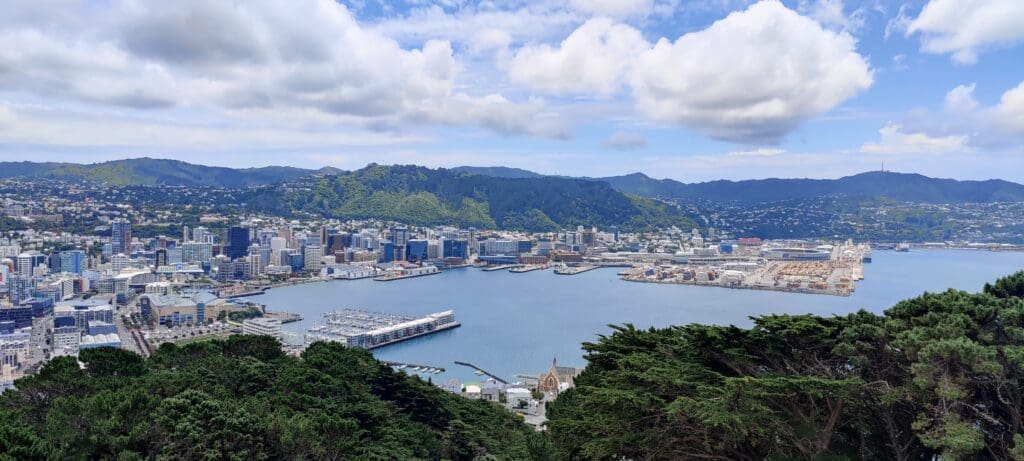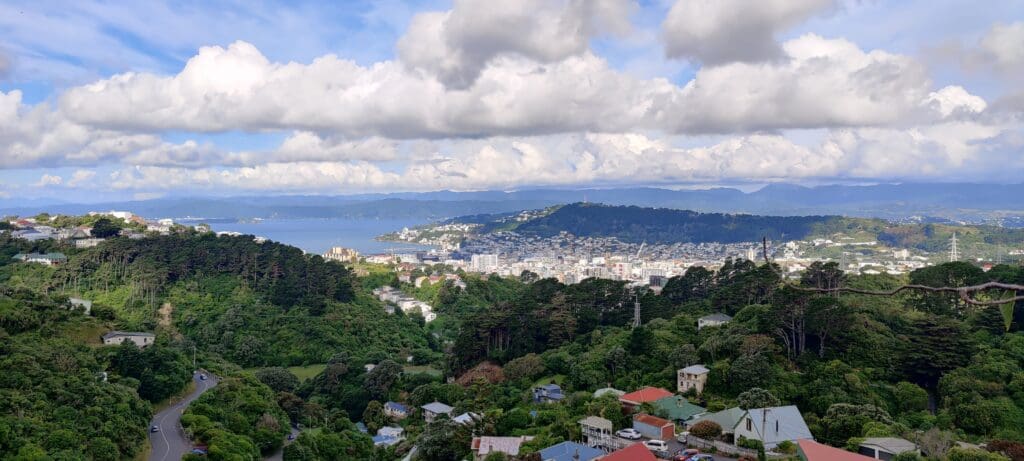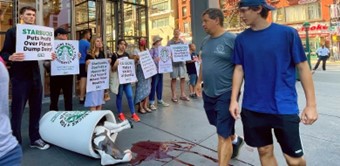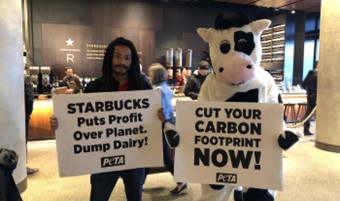Going veggie at a Gaystay…
At the southern tip of the North Island of New Zealand is the fabulous city of Wellington. Known locally as ‘Windy Welly’ because of the strong winds that blow through the Cook Straight (the body of water between the North and South Islands of New Zealand), Wellington is the capital of New Zealand and the country’s third largest city, behind Auckland and Christchurch.
Wellington (like much of the North Island of New Zealand) is also a very hilly place, and the city sits in and amongst the valleys and slopes of its rolling topography, the suburbs spilling away from the waterfront up and over a series of steep, tree-covered hills.


The view of Wellington from the summit of Mount Victoria
My wife and I were lucky to spend a few nights in Wellington over Christmas 2022. At the time we were living in a small campervan, but as there were no campsites within walking distance of the city centre, we decided to treat ourselves to an Airbnb.
As we scrolled through a few options for accommodation there was one which immediately jumped out: the ‘Korikomo Gaystay’. Between the outdoor bathtub, sauna, views from the property and offer of joining the hosts for meals, we were sold, and we arrived at the property a few days after booking. We later learned that the Gaystay was originally opened as a safe place for members of the gay community to stay in the 1970s, when New Zealand was less tolerant of the LGBT community than it is today.
The house itself had been built in sections up a steep hillside (it was 100 steps from the road to the front door) and after dropping our bags in our room, our host Chris showed us around. It turned out that, alongside the house, Chris had built a wonderful permaculture farm. It ran in tiers up the side of the property, making the most of the topography and natural resources. In addition to beehives and a wonderful range of plants, the garden produced an enormous variety of fresh produce pretty much year-round, which was turned into salads, stews and more on a nightly basis.
We stayed with Chris for four nights and ate with our fantastic hosts every evening. They were not specifically vegan or vegetarian, they simply ate what they had, and what they had was vegetables. And that is how we unintentionally ended up eating entirely vegetarian for four days; a practice that we largely carried with us into the New Year.

The view down into Wellington from our room in the Airbnb. Mount Victoria is to the right of the city centre.
…
When it comes to tackling climate change, one of the most effective and immediately impactful things that individuals can do is change their diet. A few facts are useful to inform the discussion.
– There are about 940 million cattle in the world at any given moment. About 900,000 are slaughtered every day for meat.
– There are about 33 billion chickens in the world at any given moment. About 202 million chickens are slaughtered every day for meat.
– Approximately 1.4 million goats, 1.7 million sheep, and 3.8 million pigs are slaughtered every day for meat.
– About 5 billion hectares, or 38% of the earth’s global land surface, is used for agriculture. About one-third of this is used for growing crops. The remaining two-thirds is used for grazing, or growing crops for livestock.
– Manure from cattle releases nitrous oxide. Cattle also burp methane. Over 100 years, nitrous oxide and methane have, respectively, around 300 times and 28 times more impact as greenhouse gasses, than carbon dioxide.
– Animal agriculture is responsible for approximately 65% of anthropogenic nitrous oxide emissions and 37% of anthropogenic methane emissions.
– Accounting for the nitrous oxide and methane as though they were carbon dioxide (a measure known as carbon dioxide equivalent (CO2e)), producing one kilogram of beef generates approximately 99.48kg of CO2e. Lamb and mutton generate approximately 39.72kg of CO2e. Cheese produces 23.88kg CO2e, pig produces 12.31kg CO2e and poultry 9.87kg of CO2e, all per kilogram of product. By way of comparison, producing 1kg of potatoes generates approximately 0.46kg of CO2e.
– About one-third of all the freshwater used annually is used for raising livestock or growing crops to feed livestock.
– Beef production is responsible for approximately 41% of global deforestation, as land is cleared to make space for cattle ranching, grazing, or growing feed crops.
…
Tackling climate change is horridly complex. If we are to have any hope of staying within the target set by the Paris Agreement (limiting warming to 1.5 degrees Celsius or, failing that, keeping warming as far below 2 degrees Celsius as possible) we need to target the quickest and easiest wins first.
Not all greenhouse gasses are made even; small reductions in nitrous oxide and methane equate to very large reductions in emissions of CO2. One easy place to start is by reducing the quantity of livestock – particularly beef – on Earth. To do this, we need to shift consumer behaviours, and increase the range of alternative products available.
On both fronts, there is good news. Approximately 22% of the planet is already believed to be vegetarian and whilst it is hard to find specific data, an increasing number of people around the world are turning to vegetarian, or vegan diets (700,000 people signed up globally to try a vegan diet for January in 2023, an increase of 70,000 from 2022). Demand for meat products appears to be topping out or even falling in countries around the world, and market analysts now predict what is referred to as “peak beef” in the US, EU and elsewhere, at some point in the next few years.
This trend is being helped by a range of new products that are rapidly entering the market. Whilst it has stalled a little, the market for meat alternatives is showing strong growth, generating sales of USD $14.1 billion in 2021 and forecast to reach $17.4 billion in 2027. The market for milk alternatives is also booming, with oat, almond, soy and other milk alternatives generating sales of $19.1 billion in 2022, a 6% increase from the year before. Over 15% of all milk sales in the US are now for milk alternatives.
…
There is another significant win potentially available here.
As noted above, approximately two-thirds of the world’s farmland is used for grazing, or growing crops for livestock. If we were to significantly reduce the global population of livestock, this would free up vast quantities of land which could then be applied for other purposes.
Research suggests that if we could use better farming techniques to store just 1% more carbon per year in about half the world’s agricultural soils, this would be enough to absorb about 31 gigatonnes of carbon dioxide annually – a huge contribution to reaching net zero (global CO2 emissions from energy combustion and industrial processes were 36.8 gigatonnes in 2022). If we were to materially reduce the amount of land required to rear and feed cattle, we could unlock vast spaces which could be dedicated entirely to carbon capture through improved soils. This would bring a host of associated biodiversity and other benefits also, by returning this land to nature.
…
Depending upon what you include in the figure, agriculture is responsible for around 19% of global emissions. There are many calculations which peg this number a great deal higher.
All of this has very significant implications for the business community which is currently racing to decarbonise. Food giants including Nestlé, Mondelez International, Mars, Danone, FrieslandCampina, JBS and more have all committed to reaching net zero by 2050 (and several significantly earlier). Fast food retailers such as McDonalds, KFC, Restaurant Brands International (which owns Burger King, Tim Hortons and more) and many others have all made similar commitments.
The reality of achieving net zero across these businesses is, of course, very complex, in circumstances where there is no carbon-neutral way of producing products like beef, cheese, poultry or dairy, all of which feature heavily on the menus and shelves of the businesses noted above.
As food businesses embark upon their decarbonisation journeys, they need to be mindful of increasing investor and public scrutiny, not only in relation to the genuineness of their commitment to net zero targets but also the manner in which these transitions are being delivered.
By way of just one example, Starbucks (where emissions from dairy account for 22% of their overall CO2 emissions) currently charges extra for drinks made with milk alternatives (like many coffee companies). This caught the eye of protestors, who labelled the surcharge a vegan tax and arranged a series of protests, which heavily focused on the environmental impact of dairy farming.


Protests against Starbucks organised by PETA, People for the Ethical Treatment of Animals
…
According to the Global Footprint Network, if everyone in the world lived like the average Bangladeshi, we could live sustainably on an Earth the size of Asia. If everyone lived like the average Chinese person then the Earth would be about the right size for us to live sustainably. For everyone on this planet to live like the average American, we would need approximately four Earths.
If we are to have any hope of one day reaching net zero, the global food system, and what we eat, are going to have to change – in many cases quite radically. The good news is that, done right, this alternative system could be an immense force for good. Re-imagined food systems would use significantly fewer pesticides and other chemicals, which ultimately find their way into our waterways and oceans. They would promote immense biodiversity through redesigned farming practices, helping to capture carbon and replenish the water table in the process. They could help reduce the impact of increasingly frequent extreme weather events and feed an increasing global population a larger diet of high-quality and more nutritious food than we currently consume. And it could achieve all of these things, at the same time, whilst also using less land than we currently use for agriculture – if we can be bold enough in the scale of our ambition.
…
Since leaving Wellington my wife and I have continued to eat a largely vegetarian diet. In particular, we have significantly cut back on the amount of beef and lamb that we eat, which is now much more of an occasional treat. I increasingly order oat milk coffees when I am out, and whilst I once tended to ignore them I do now look at the vegetarian options on menus in restaurants. I probably end up ordering something vegan or vegetarian 50% of the time.
None of these things particularly feels like a chore. I do not feel like I have given something up – in many ways I have gained a whole new variety in my diet. But I am clear, as someone passionate about the environment and climate change, that these small adaptations on my part have a disproportionately large impact when it comes to my overall carbon footprint and the broader changes that, as a society, we will collectively need to achieve.
…
In his excellent book “We are the Weather”, Jonathan Safran Foer writes the following:
“Unless you buy and eat your food in secret, you don’t eat alone. Our food choices are social contagions, always influencing others around us – supermarkets track each item sold, restaurants adjust their menus to demand, food services look at what gets thrown away, and we order “what she’s having”. We eat as families, communities, nations, and increasingly as a planet. Individual consumer choices can activate a “complex, recursive dynamic” – collective action – that is generative, not paralyzing…. We couldn’t stop our eating from radiating influence even if we wanted to.”
In a world where it is so easy to feel powerless to make any sort of appreciable difference in relation to the nightmare that is climate change, this insight is quite empowering. Each of us can make a real difference, and influence the broader system, every day, simply by being a little more mindful about what we choose to eat.
There is no getting away from the reality: our planet is an animal farm. But it need not be an Orwellian nightmare. We can choose a different way. And we can all be collectively richer for it.
Sources
https://www.statista.com/statistics/263979/global-cattle-population-since-1990/
https://worldanimalfoundation.org/advocate/how-many-chickens-are-in-the-world/
https://ourworldindata.org/how-many-animals-get-slaughtered-every-day
https://www.ey.com/en_uk/strategy/how-alternative-proteins-are-reshaping-meat-industries
https://www.wired.co.uk/article/beyond-plant-based-meat
https://www.theguardian.com/environment/2023/jan/16/netherlands-european-union-regulations-livestock
https://awellfedworld.org/wp-content/uploads/Livestock-Climate-Change-Anhang-Goodland.pdf
https://www.iea.org/reports/co2-emissions-in-2022
Book: ‘We are the Weather’ by Jonathan Safran Foer.
Get in touch
We opened our doors on 4 March 2024. As a relatively new firm, we are not yet in a position to offer all of the services described on this website. We have done our best to make clear what we can do now, and what forms part of our exciting plans for the years ahead. We are working hard to make our ambitious vision into a reality.
In the meantime, please do subscribe to receive our regular thought leadership and feel free to follow our journey and progress on LinkedIn.
